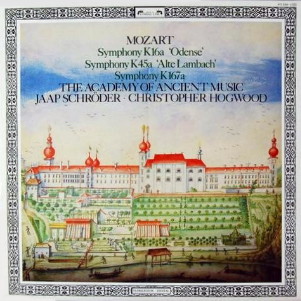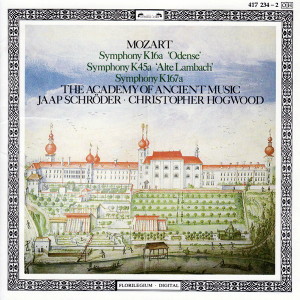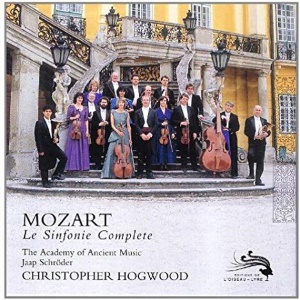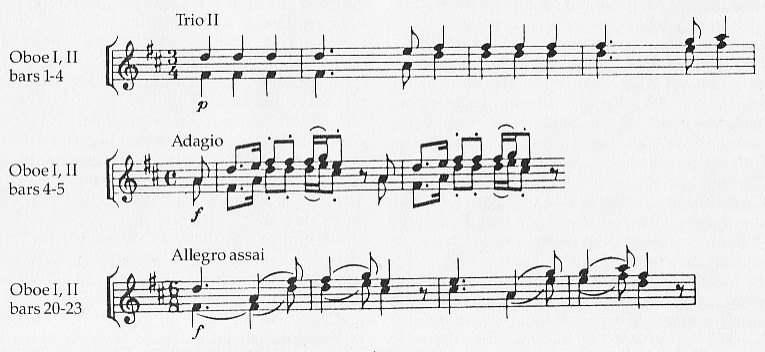 |
|
1 LP -
417 234-1 - (p) 1986
|
 |
| 1 CD -
417 234-2 - (p) 1986 |
 |
| 19 CD's
- 480 2577 - (p & c) 2009 |
|
| Wolfgang Amadeus
Mozart (1756-1791) |
|
|
|
|
|
|
|
| Symphony in A
Minor "Odense", K. 16a |
|
13'
34"
|
|
| -
[Allegro moderato ∑ Andantino ∑
Rondo: Allegro moderato] |
|
|
|
| Symphony
in G Major "Alte Lambach", K. 45a |
|
14' 23" |
|
| -
[Allegro ∑ Andante ∑ Menuetto &
Trio ∑ Finale] |
|
|
|
|
|
|
|
| Symphony
in D Major, K. 185 / K. 167a |
|
28' 05" |
|
| -
[Allegro assai ∑ Andante grazioso ∑
Menuetto & Trio ∑ Adagio-Allegro
assai] |
|
|
|
|
|
|
|
THE ACADEMY OF ANCIENT MUSIC
(on authentic instruments) A=430 - directed
by
|
|
| Jaap SchrŲder,
Concert Master |
|
| Christopher
Hogwood, Continuo |
|
|
|
|
|
Luogo
e data di registrazione |
|
St.
Barnabas' Church, London (United
Kingdom):
- gennaio 1984 (K. 167s)
Walthamstow Assembly Hall, London
(United Kingdom):
- agosto 1985 (K. 16a, 45a)
|
|
|
Registrazione: live /
studio |
|
studio |
|
|
Producer / Engineer |
|
Morten
Winding / John Dunkerley |
|
|
Prima Edizione LP |
|
Oiseau
Lyre - 417 234-1 (1 LP) - durata
56' 02" - (p) 1986 - Digitale |
|
|
Prima Edizione CD |
|
Oiseau
Lyre - 417 234-2 (1 CD) - durata
56' 02" - (p) 1986 - ADD |
|
|
Edizione Integrale CD |
|
Decca
(Editions de l'Oiseau-Lyre) - 480
2577 (19 CD's) - (p & c) 2009
- ADD / DDD
|
|
|
Note |
|
-
|
|
|
|
|
|
|
Symphony
in G major, K.45a
(A221)
At the beginning of January
1769 the Mozart family
stopped at the
Benedictine monastery at
Lambach, which, like
many monasteries,
provided rooms and meals
for travellers, and
maintained an orchestra
andchoir for worship and
entertainment. It
was a convenient
way-station for the
Mozarts on journeys
between Salzburg and
Vienna, and the abbot
was a family friend.
This visit, not
mentioned in the
Mozarts' correspondence
or diaries, is known
solely from inscriptions
on two musical
manuscripts. Both are
sets of parts for
symphonies in G major,
one inscribed Sinfonia
/ a / 2 Violini / 2
Oboe / 2 Corni / Viola
/ e / Basso. / Del
Sig:re
Wolfgango
/ Mozart. / Dono
Authoris / 4ta Jan:
769 and the other
bearing an identical
inscription with
'Leopoldo' in place of 'Wolfgango'.
Alfred Einstein, in
assigning Wolfgangís
work the number 45a in
the 3rd edition of the KŲchel
Catalogue (1937),
guessed that it was
composed in 1768 while
the 12-year-old composer
was in Vienna.
Subsequently however, it
was discovered that the
Lambach manuscripts were
the work of a Salzburg
copyist and must have
been copied there in
1767. In recent years it
was proposed, and widely
accepted, that the two works
had carelessly been
interchanged by a
librarian at Lambach.
(For details of this
proposal and for
Leopold's Lambach
symphony see Volume 7 of
the Mozart symphonies on
D173D3).
The confusion was
resolved in February
1982 when the Munich
Staatsbibliothek
announced the
rediscovery of the
original parts for K.45a,
comprising first and
second violin in the
hand of a copyist, 'basso'
part in the hand of
Mozartís sister Nannerl,
and the rest in
Leopoldís hand. The
title page in Leopoldís
hand is virtually
identical to that on the
Lambach copy but ends 'ŗ la
Haye 1766'.
K.45a
therefore forms a
pendant to the Symphony
in B flat, K.22, also
composed at the Hague,
where the Mozarts were
enthusiastically
received (see Volume 1
on D167D3). These two
symphonies may have been
written (with the Galimathias
musicum,
K.32) for the
investiture of Prince
William of Orange. In
that case they were what
Leopold referred to in a
letter when he wrote
that Wolfgang 'had
to compose something for
the Prince's concert' of
11 March 1766.
Comparison of the Hague
and Lambach manuscripts
reveals that K.45a was
revised in Salzburg in
1767: no bars of music
were added or removed
and no new ideas
introduced; rather,
dozens of details were
altered, especially in
the inner parts. The
revision of K.45a
suggests its performance
in Salzburg between
December 1766 and
October 1767, after
which the work was taken
on tour to Vienna.
The first movement of K.45a
begins with the melody
in the bass and tremolo
in the violins, a
texture that Mozart
usually reserved for
near the ends of
expositions and of
recapitulations. In a
number of his early
symphonies the incipits
of the first and last
movements have similar
melodic contours; in
K.45a however, the
second or lyrical
subjects of those
movements are so
related. The 3/8 finale
is so much of a piece
with the 3/8 finales of
the other early
symphonies, K.16, 19,
19a and 22, that all may
be said to belong to the
same general conception.
As for the Andante,
the Lambach version is
the first of Mozartís
symphonies to use a
favourite orchestral
texture found in the
andantes of eight later
symphonies: the wind are
silent or reduced,
violins muted, and
cellos and basses play
pizzicato. But mutes and
pizzicato are not
indicated in the Hague
version, and the
occasional slur in the
bassline shows that
pizzicato was not
intended by the
ten-year-old composer.
This is the first
recording of the
original version of K.45a.
Symphony in Aminor,
K.16a (A220)
In February 1983
newspapers in many
countries reported the
rediscovery of a lost
Mozart symphony The
facts as they later
emerged were these: the
librarian of the
municipal orchestra in
Odense, Denmark, was
examining a collection
of music which at the
end of the eighteenth
century had belonged to
the local Collegium
Musicum. Among several
late-eighteenth-century
symphonies, the
librarian found the lost
Symphony in A minor, K.6a.
According to an
annotation on its title
page, K.16a came into
the possession of the
Collegium no later than
1793, but this set of
parts was not new then
for the watermark in the
paper used reads '1779'.
None of the hands in the
Odense parts belongs to
a copyist associated
with the Mozarts or
their circle.
How
did it happen that a
work previously unknown
can have had a KŲchel
number waiting for it?
The answer is that when,
from around 1799, the
Leipzig publishers
Breitkopf & Hšrtel
attempted to collect
Mozartís works from his
sister, his widow and
musicians, copyists and
publishers all over
Germany and Austria,
they were sent this
symphony. It was duly
listed in their
manuscript catalogue of
Mozartís works, with an
incipit of four bars of
the first violin part
and the workís source: 'Westphal'.
(This was the Hamburg
music dealer Johann
Christoph Westphal.) By
KŲchel's
time, this manuscript
had vanished, and he
placed the work in his
appendix for lost works
as Anhang 220. In
the 3rd edition of the KŲchel
Catalogue, Einstein
speculatively inserted
such incipits of lost
works into the
chronological sequence
of works. Solely on the
evidence of the incipit,
he guessed that the
workís style was
Mozartís earliest and
closely related to that
of J.C.Bach
and C.F. Abel,
whose symphonies Mozart
studied in London in
1764-65 (see Volume 1).
He therefore arbitrarily
assigned it a number
immediately following
Mozartís earliest
surviving symphony K.16,
of 1764.
With the music in hand,
we may guess that the
work is later. But even
if it may be
stylistically closer to
Mozartís symphonies of
the later 1760s and
early 1770s, without an
authentic source it can
be neither firmly
attributed nor precisely
dated. Indeed, many
things about K.16a
are stylistically unlike
any work of Mozartís.
The opening Allegro
moderato presents
two contrasting motives
- a descending broken
chord, sforzando
and unisono, and
a more lyrical idea, piano
- organized into
three-bar phrases and
providing the material
for the first thirty
bars, which end (as
expected) in C major.
The second theme group
begins with a new idea,
and at bar forty-eight
the exposition ends
(astonishingly) in F
major, with a closing
theme derived from the
lyrical idea of the
opening. There is no
repeat. The development
section begins with the
expositionís closing
theme and then offers a
modulatory section
leading to an incomplete
recapitulation and
closing ritornello.
The second movement, a
short sonata form, opens
with a songful theme
that, like a few of
Mozartís other early
symphony andantes, is
reminiscent of 'Che farÚ
senza Euridice'
from Gluck's Orfeo.
The finale, like those
of many of Mozartís
early symphonies, is a
rondo. Its refrain has
some of the 'exotic'
flavour that Mozart and
his contemporaries
called 'Turkish',
which was apparently an
imitation of music of
Hungarian peasants who
themselves parodied what
they took to be Turkish
music.
Symphony in D major,
K.167a (K.185)
Orchestral serenades and
symphonies had different
functions. Serenades
provided entertainment
for such celebrations as
birthdays, promotions,
ends of school terms,
investitures, and the
like; whereas symphonies
were the briefer
prefaces to more formal
occasions: plays,
operas, oratorios and
concerts. As Mozartís
Salzburg serenades were
made up of a march,
minuets, concerto
movements, and symphony
movements, they could
easily be raided for
suitable movements when
symphonies were needed.
Of Mozartís six
orchestral serenades,
symphony versions
survive for five of
them. In the
sixth and present
instance, no symphony
version
survives, but there must
have been one as the
work was listed as a
symphony in the already
mentioned Breitkopf
& Hšrtel
manuscript catalogue.
The date on the
autograph of K.167a
('August 1773'?) was
tampered with and is
nearly illegible. If,
as is generally
believed, the work is
'the Finalmusik
for Antretter' mentioned
in the Mozarts'
correspondence, then it
was written for the end
of the Salzburg
University term,
celebrated annually in
early August. In August
1773 the Mozartís friend
Judas
Thaddšus
Antretter was completing
his fourth year at the
University. The symphony
version was presumably
made sometime shortly
thereafter.
The first movement, Allegro
assai in common
time, begins with a
theme in the bass, which
returns at the beginning
of the recapitulation
and, in unison and in
contrary motion, at the
ends of the exposition
and recapitulation. As
in a number of Mozartís
other D major movements,
brilliance and pomp is
contrasted with lighter
and even comical ideas,
while lyricism is
conspicuously avoided.
In characteristically
expansive serenade
spirit, this sonata-form
movement has both
sections repeated and a
full coda. Yet despite
the striving for length,
the development section
is slight and the
overall spirit closer to
an Italian opera
overture than to an
Austrian concert
symphony.
The andante grazioso
which follows (the tempo
indication was written
by Leopold, not
Wolfgang) is in A major
and the customary 2/4.
Trumpets and drums fall
silent, a pair of flutes
replaces the oboes of
the other movements, and
the mood turns lyrical.
After an imitative
opening with the wind
prominent, the violins
dominate the rest of the
movement in a homophonic
texture of a binary form
with both halves
repeated and a coda.
In the Minuet the full
band returns and the
movement opens with a
fanfare used by Mozart
in a number of other
pieces. Here, the
character seems stagey
and perhaps even
burlesque. The first
Trio calls for upper
strings alone, with a
mock-pathetic violin
solo in D minor
providing a jarring
contrast to the
hurly-burly of the
Minuet proper. The
second Trio, in D major,
features the wind in an
attractive al fresco
style.
An eleven-bar Adagio
in which stern unisons,
noble dotted rhythms,
and touches of
chromaticism momentarily
thrust us into the world
of tragic opera opens
the finale. But Mozart
is only teasing, for
this solemn introduction
leads to a spirited 6/8
jig (Allegro assai,
in Leopoldís hand),
rounding off the
symphony in high
spirits. This jig is a
largescale sonata-form
movement with a fine
development section and
full coda in which, as a
final surprise, Mozart
inserted a so-called 'Mannheim
crescendo'. The D major
Trio, the Adagio
introduction, and the
principal theme of the
jig are linked by
transformations of a
common wind motive:

©
1986
Neal Zaslaw
|
|
|

